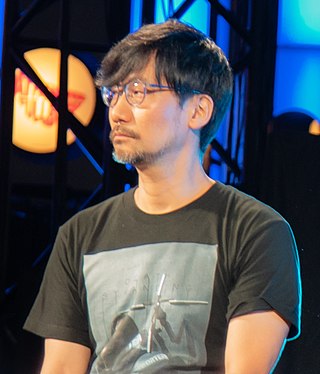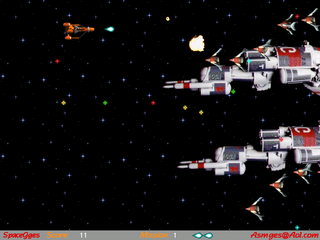
Cyberpunk is a subgenre of science fiction in a dystopian futuristic setting said to focus on a combination of "low-life and high tech". It features futuristic technological and scientific achievements, such as artificial intelligence and cyberware, juxtaposed with societal collapse, dystopia or decay. Much of cyberpunk is rooted in the New Wave science fiction movement of the 1960s and 1970s, when writers like Philip K. Dick, Michael Moorcock, Roger Zelazny, John Brunner, J. G. Ballard, Philip José Farmer and Harlan Ellison examined the impact of drug culture, technology, and the sexual revolution while avoiding the utopian tendencies of earlier science fiction.
Syfy is an American basic cable television channel, which is owned by the NBCUniversal Media Group division and business segment of Comcast's NBCUniversal. Launched on September 24, 1992, the channel broadcasts programming relating to the science fiction, horror, and fantasy genres. As of November 2023, Syfy is available to approximately 69,000,000 pay television households in the United States-down from its 2011 peak of 99,000,000 households.

Hideo Kojima is a Japanese video game designer. He is regarded as an auteur of video games. He developed a strong passion for film and literature during his childhood and adolescence. In 1986, he was hired by Konami, for which he designed and wrote Metal Gear (1987) for the MSX2, a game that laid the foundations for stealth games and the Metal Gear series, his best known and most appreciated works. At Konami, he also produced the Zone of the Enders series, as well as wrote and designed Snatcher (1988) and Policenauts (1994), graphic adventure games regarded for their cinematic presentation.

A video game genre is an informal classification of a video game based on how it is played rather than visual or narrative elements. This is independent of setting, unlike works of fiction that are expressed through other media, such as films or books. For example, a shooter game is still a shooter game, regardless of where or when it takes place. A specific game's genre is open to subjective interpretation. An individual game may belong to several genres at once.
A massively multiplayer online game is an online video game with a large number of players to interact in the same online game world. MMOs usually feature a huge, persistent open world, although there are games that differ. These games can be found for most network-capable platforms, including the personal computer, video game console, or smartphones and other mobile devices.
In video games, a clan, community, guild or faction is an organized group of video game players that regularly play together in one or more multiplayer games. Many clans take part in gaming competitions, but some clans are just small gaming squads consisting of friends. These squads range from groups of a few friends to four-thousand plus person organizations, with a broad range of structures, goals and members. The lifespan of a clan also varies considerably, from a few weeks to over a decade. Numerous clans exist for nearly every online game available today, notably in first-person shooters (FPS), massively multiplayer games (MMO), role-playing video games (RPG), and strategy games. There are also meta-groups that span a wide variety of games. Some clans formed by groups of players have grown into multi-million dollar professional esports teams.

Policenauts is a graphic adventure game developed and published by Konami. It was written and directed by Hideo Kojima, and originally released for the PC-9821 in 1994. A hard science fiction story, Policenauts is set in the mid 21st century and follows Jonathan Ingram, an astronaut recently recovered floating in space in cryosleep after an accident at a space colony sent him drifting into space for 24 years. Now a detective in Los Angeles, Ingram travels back to the colony to investigate the murder of his ex-wife and her husband's disappearance. As he begins his investigation, he starts to uncover an illegal organ trafficking ring.

SFX is a British magazine covering the topics of science fiction and fantasy. Its name is a reference to the abbreviated form of "special effects".
An action role-playing game is a subgenre of video games that combines core elements from both the action game and role-playing genre.

William C. Dietz is an American science fiction writer, principally of military science fiction novels and video game novelizations.
Japanese cyberpunk refers to cyberpunk fiction produced in Japan. There are two distinct subgenres of Japanese cyberpunk: live-action Japanese cyberpunk films, and cyberpunk manga and anime works.

A first-person shooter (FPS) is a video game centered on gun fighting and other weapon-based combat seen from a first-person perspective, with the player experiencing the action directly through the eyes of the main character. This genre shares multiple common traits with other shooter games, and in turn falls under the action games category. Since the genre's inception, advanced 3D and pseudo-3D graphics have proven fundamental to allow a reasonable level of immersion in the game world, and this type of game helped pushing technology progressively further, challenging hardware developers worldwide to introduce numerous innovations in the field of graphics processing units. Multiplayer gaming has been an integral part of the experience, and became even more prominent with the diffusion of internet connectivity in recent years.
Project Itoh, real name Satoshi Itō, was a Japanese science fiction writer and essayist.

Metal Gear is an action-adventure stealth video game developed and published by Konami for the MSX2. It was released for the system in Japan and parts of Europe in 1987. Considered to have popularized the stealth game genre, it was the first video game to be fully developed by Hideo Kojima, who would go on to direct most of the games that followed in the Metal Gear series. A reworked port of the game was released for the Famicom a few months later, which later saw release in international markets for the NES over the following two years; this version was developed without Kojima's involvement and features drastically altered level designs, among other changes.

Pop culture fiction is a genre of fiction where stories are written intentionally to be filled with references from other works and media. Stories in this genre are focused solely on using popular culture references.

The Creative Gene: How Books, Movies, and Music Inspired the Creator of Death Stranding and Metal Gear Solid is an autobiographical book written by Japanese video game designer Hideo Kojima, published on October 12, 2021, by Viz Media. Based on the collection of essays titled The Gifted Gene and My Lovable Memes which was published in Japan in 2019, the book focuses on Kojima's inspirations on his work from various pop culture media, such as books, movies and music. Exploring themes such as isolationism, loneliness, grief and death, The Creative Gene collocates personal anecdotes of Kojima's life involving his inspirations with his sentiments towards the multitude of works that inspired him. The Creative Gene received positive reviews from critics, with praise given towards Kojima's exploration of his inspirations and their influence on his life.
Nebulae is a sci-fi massively multiplayer online (MMO) strategy game developed and published by Northern Lights Entertainment (NLE), a French-based company. Mobile alpha was released in 2023. The game combines massively multiplayer politics and combat in space.










